|
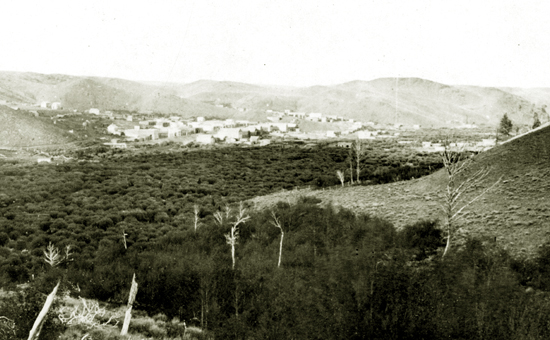
Atlantic City, 1870. Photo by William Henry Jackson.
Some 4 1/2 miles from South Pass City was Atlantic City founded in 1868 by
Colonel Charles W. Tozer, Charles Collins and H. A. Thompson with the discovery of the Atlantic Lode.
Colonel Tozer (also spelled Tozier in some accounts) established a six stamp mill in Hermit Gulch. The mill ran for about
four months from mid-summer 1868 until November when it suspended operations. The mill's manager was
E. B. Eddy. By 1869, in Atlantic City it was "selling time," the bloom was off the rose as they say.
Even though By 1870, the town supposedly attained a population of 2,000. This, as in the case of
South Pass City, was probably an exaggeration. The 1870 census only reflected
a population of 321 whites and 4 blacks.
Colonel Tozer (1830-1905) had previously served as Speaker of the Nevada Territorial Assembly and later became a
mining engineer of note, prospecting for precious metals or developing mines in California,
Nevada, Arizona, Alaska, Siberia, China and Japan.
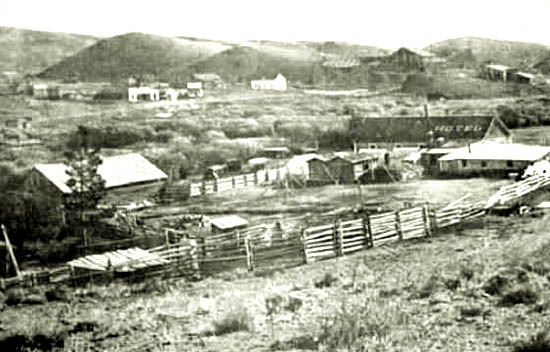
Atlantic City, approx. 1914.
On the hill on the upper right in the
above photo is the Dexter Mill.
The Dexter Mill, also known as the
Timba Bah mill was constructed between 1905 and 1908 and had twenty 1,050 lb stamps. The mill was also
equipped for cyanide treatment. With the fading of the 1901 gold boom in the South Pass area, the
mill was never in regular operation. The stamping mill would process small quantities of ore brought
in on wagons. The cyanide plant was never put into operation.
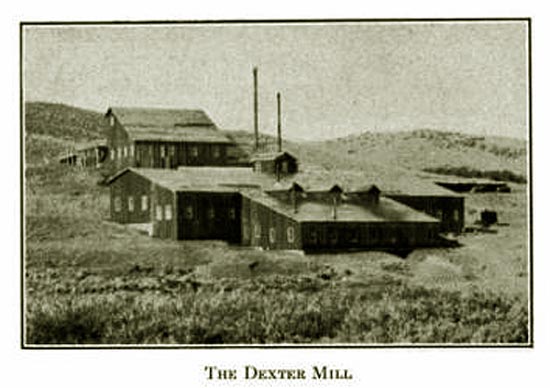
Dexter Mill and Mine, Atlantic City, 1911.
The Dexter Mining & Milling Co. was unable to find any
ore bodies on its property. In 1914, it was placed in bankruptcy and reorganized as the Timba Bah Mining
Company. Writing in 1914, the State Geologist, L. M. Trumbull, in a report on the Atlantic City Gold Mining
District explained:
At Atlantic City is the Dexter Mill, now part of the
property of the Timba Bah Mining Company. This mill
is an example of the kind of mine management that furnishes
the topic for so many stories and jokes among real mining
men. The mill, costing several times its value, was built
beside the townsite and the manager's office, although there
was no mine near and the slope was too slight to allow the
material to be handled by gravity. After the completion
of the mill, ore was hauled in wagons from various prospects
in the district. Twelve thousand tons of five to thirty
dollar ore were milled, and the cleanup gave six thousand
dollars off the plates and absolutely nothing from the cyanide
plant. After the company had sold seven hundred thousand
dollars' worth of stock, it became bankrupt. Fraud
and ignorance played about equal parts in the management
of the company affairs. The whole affair naturally was no
help to the reputation of the district.
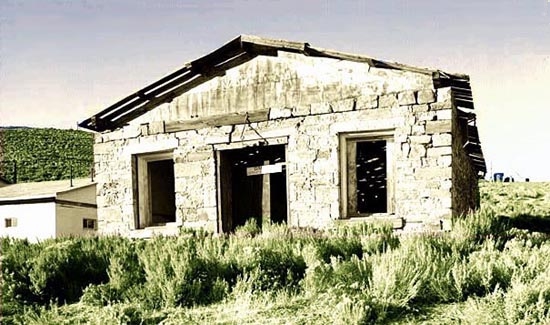
Hyde's Hall, Atlantic City, 1977
The building was constructed by J. W. Anthony and was used by Robert McAuley as a store.
The building was originally two stories. Following an earthquake the second story was removed. In
the 1920's the building was renovated by Tom Hyde who used it as a dance hall. On the hill, on private property, behind the
hall, is a single lonely marked grave, "Lydia Mae, only daughter of R. & L. McAuley, 1874."
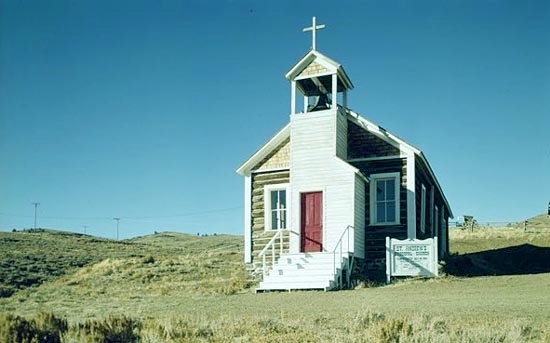
St. Andrew's Episcopal Church, Atlantic City, 1977
St. Andrew's was consecrated in 1913.
Mines in Atlantic City included, the
Atlantic City Mine,
Caribou Mine
Caroline Mine,
Ground Hog Mine,
Mary Ellen mine,
Rose Mine,
Snowbird Mine,
St Louis Mines,
Tabor Grand Mine, and
Goodhope Mine.
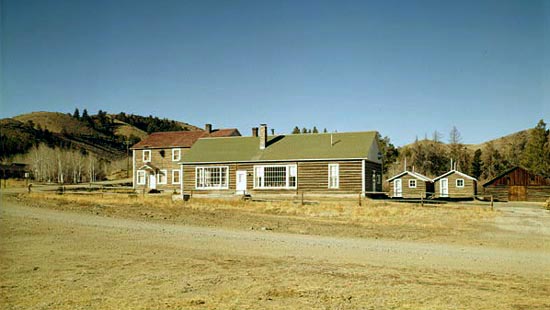
Carpenter Hotel, Atlantic City, 1977.
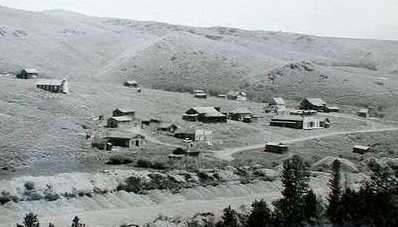 Atlantic City
The town claimed the honor of
having the first brewery in the Territory. Atlantic City was noted for its "French"
section which appealed to lonely miners. After the intial gold rush the town
began to fade until the arrival of French engineer Emile Granier who attempted to revive mining.
On behalf of French interests he purchased a number of placer claims and commendced the construction
of a 16-mile long ditch to provide water for large scale placer operations. Others attempted to revive mining including
Colorado mining magnate Horace Tabor. Rufas "Fatty" Ricetts, a former freighter, also gained control of several
mines and at one time threatened the life of Granier. Nellie Carpenter, the wife of one of Granier's employees Clarence
Carpenter began serving meals to miners. The operation changed over the years from meals to proving lodging for miners, ultimately
to a boarding house with tent cabins which slowly grew into a small hotel. The facility is now operated as a
bed and breakfast.
Atlantic City
The town claimed the honor of
having the first brewery in the Territory. Atlantic City was noted for its "French"
section which appealed to lonely miners. After the intial gold rush the town
began to fade until the arrival of French engineer Emile Granier who attempted to revive mining.
On behalf of French interests he purchased a number of placer claims and commendced the construction
of a 16-mile long ditch to provide water for large scale placer operations. Others attempted to revive mining including
Colorado mining magnate Horace Tabor. Rufas "Fatty" Ricetts, a former freighter, also gained control of several
mines and at one time threatened the life of Granier. Nellie Carpenter, the wife of one of Granier's employees Clarence
Carpenter began serving meals to miners. The operation changed over the years from meals to proving lodging for miners, ultimately
to a boarding house with tent cabins which slowly grew into a small hotel. The facility is now operated as a
bed and breakfast.
Unfortunately drought ruined Granier's placer scheme and several mine explosions killed hopes for a revival
of the town. About 1900 Granier returned to
his native France destitute and spent his last years in debtors' prison.
Hopes for the town's revival again arose with the Dexter Mine in 1904 and revived placer mining in the 1920's by the E. T. Fisher Company. The Fisher
operations closing with the advent of World War II when the government declared gold not to be
a critical metal. Mining operations in Atlantic City revived again in the 1962 with the coming of surface
iron ore mining, but were dashed with cessation of operations in 1983.
According to W. Dan Hausel, citing finds of significant placer gold and writing in the March 2007 edition of Coutcrop, the Newsleter of the
Rocky Mountain Assoiciation of Geologists, the South Pass area "potentially contains more that a billion dollars in gold."
M/p>
Next Page: Miner's Delight.
|